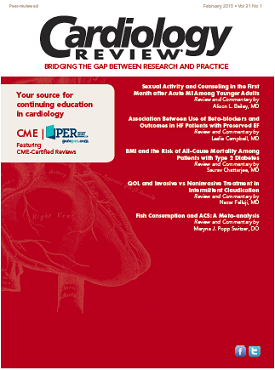QOL and Invasive vs. Noninvasive Treatment in Intermittent Claudication
Obstructive peripheral artery disease (PAD) manifests itself with intermittent claudication (affecting 20 to 40 million individuals worldwide), which is described as exertional lower extremity pains, and in more advanced stages with critical limb ischemia and acute or chronic limb ischemia. Irrespective of presentation, patients with PAD are at increased risk for adverse cardiovascular (CV) events. Therefore, risk factor modification is the cornerstone of the management of PAD.

Nezar Falluji, MD
Review
Nordanstig J, Taft C, Hensater M, Perlander A, Osterberg K, Jivegard L. Improved quality of life after 1 year with an invasive versus a noninvasive treatment strategy in claudicants: one-year results of the Invasive Revascularization or Not in Intermittent Claudication (IRONIC) Trial. Circulation, 2014. 130(12):939-947.

Lower extremity peripheral arterial disease (PAD) is estimated to affect more than 200 million people worldwide, with the majority of patients harboring asymptomatic PAD.1 Obstructive PAD manifests itself with intermittent claudication (affecting 20 to 40 million individuals worldwide), which is described as exertional lower extremity pains,2 and in more advanced stages with critical limb ischemia and acute or chronic limb ischemia. Irrespective of presentation, patients with PAD are at increased risk for adverse cardiovascular (CV) events. Therefore, risk factor modification is the cornerstone of the management of PAD.3-5
Study Details
The Invasive Revascularization or Not in Intermittent Claudication (IRONIC) trial was a single-center, open-label, prospective, randomized trial of patients with stable, moderate intermittent claudication (IC) symptoms.6 A vascular surgeon evaluated consecutive IC patients who were referred to a single center in Sweden. Patients with severe claudication (defined in the trial as patients unable to work due to IC or with occasional ischemic rest pains) or with “very mild IC” (no specific criteria were provided for that definition) were excluded. Patients who were older than 80 years of age, weighed more than 120 kg, or had 2 prior failed ipsilateral vascular interventions were excluded as well. Based on sample size and power calculation, 158 patients were randomized to either an invasive revascularization strategy (invasive group, 79 patients) or a noninvasive medical management strategy (noninvasive group, 79 patients). The study design allowed for crossover between the 2 groups (if symptoms improved or deteriorated).The patients were evaluated at baseline and followed at 3, 6, and 12 months.
All patients were educated regarding PAD, instructed to perform at least 30 minutes of submaximal walking sessions at least 3 times a week, received aspirin 75 mg/d (or clopidogrel 75 mg/d), a statin (dose not specified), and cilostazol100 mg twice daily (stopped at 3 months if there was no improvement in IC). The patients’ general practitioners were to address risk factors modification and follow the patients in accordance with guidelines. Revascularization strategies followed the Trans-Atlantic Inter-Society Consensus (TASC II) guidelines.4 Procedure-related complications, reintervention, and cardiovascular events were prospectively recorded.
The primary end point was health-related quality of life (HRQoL); assessed with 2 well-established and validated questionnaires:the generic Medical Outcomes Study Short Form 36 version 1 (SF- 36)7 and the Vascular Quality of Life Questionnaire (VascuQoL).8 SF-36 is a questionnaire that includes 36 items covering different aspects of HRQoL, generating 8 different domain scores (physical functioning, role physical, bodily pain, general health, vitality, role emotional, social functioning, and mental health).The VascuQoL is a peripheral vascular disease-specific questionnaire for HRQoL outcome measurement, and it consists of 25 items subdivided into 5 domains: activities, symptoms, pain, emotional, and social. Each question has a 7-point response scale.
Secondary endpoints included intermittent claudication distance (ICD), maximum walking distance (MWD), and hemodynamic measurements with ankle-brachial index (ABI) calculation.
Event-free survival was defined as the composite of survival and freedom from procedure-related complications, reinterventions, and cardiovascular events.
The IRONIC researchers reported that 1-year attendance rates were 90% and 96% in the invasive versus noninvasive groups, respectively. In the invasive group, 90% of the patients received a revascularization procedure (73% endovascular, 27% open or hybrid procedures) after a mean time of 20 weeks. In the noninvasive group, 92% of patients were managed noninvasively and 8% (6 patients) needed an invasive procedure during follow-up (5 patients due to worsening claudication and 1 for acute limb ischemia. All were successfully treated).
A significantly larger improvement in HRQoL (in both SF-36and VasculoQoL questionnaires) was found in the invasive versus the noninvasive group at 12 months. The improvement was derived by improvement in 2 of the SF-36 physical subscales (physical functioning and bodily pain) and 3 of theVascuQoL domains (activities, symptoms, and emotional). Furthermore, intergroup comparisons revealed a significant improvement in HRQoL between baseline and 12 months in both groups.
In comparison with an age- and sex-matched reference sample, there was no difference at 12 months for the invasive group regarding any of the SF-36 variables, whereas all but 1 (role physical) of the SF-36 subscales were significantly lower than the reference sample for the noninvasive group.
The change in ICD was larger in the invasive than in the noninvasive group (P=.003). The change in MWD was not different between treatment groups (P=.170). Intragroup comparisons showed that both treatment groups were significantly (P<.01) improved in ICD and MWD compared with baseline.
ABIs at 12 monthswere higher in the invasive versusthe noninvasive group, 0.85 versus 0.69 (P<.001)
The 12-month mortality rate, amputation rate, and nonfatal CV events for the entire study population was 0.6%, 0%, and 2.5%, respectively. One patient died from a myocardial infarction unrelated to revascularization. There were 4 cardiovascular events (2 in each arm) that were unrelated to revascularization. There were 3 access-related complications, 2 in the invasive group and 1 in the noninvasive group (all managed successfully). Event-free survival at 12 months was 77% in the invasive versus 88% in the noninvasive group.
COMMENTARY
Trying to address an important subset of patients with claudication
IC is a common medical problem with significant public health and socioeconomic implications. The management of IC entails risk factor modification to prevent adverse CV events, ameliorating claudication, and increasing walking distance. Patients with mild IC, who are not limited by IC in their daily activities or capacity to work, can be managed effectively with optimal medical therapy (OMT) complimented by walking exercises (a physiotherapist-supervised walking program is more effective than recommending walking exercise,9-11 although such programs are not widely available). Patients with severe, lifestyle-limiting IC will very likely require early revascularization (along with OMT and walking exercises) to ameliorate claudication, improve functional capacity, and limit progression to critical limb ischemia. In patients with moderate IC, an argument could be made for an early invasive strategy or for a conservative strategy with walking exercises to increase ICD and revascularization if IC worsens. The IRONIC trial sought to address this important subset of patients with claudication. Taking into account that a primary objective in treating these patients is to alleviate symptoms (which are best judged by the patient), the investigators used qualitative HRQoL tools to assess response to invasive versus noninvasive management strategies.
Some observations can be made from this important study:
- The study demonstrated that an invasive strategy improves HRQoL more than medical management in patients with moderate IC. The HRQoL status at 12 months in the invasive group corresponded with that of an age- and sex-matched sample of the general population.
- Revascularization procedures, in adherence with guidelines, are well tolerated, with no significant major complications.
- The improvement in the HRQoL correlated with the improvement in ICD but not with MWD. ICD is argued to be a better indicator of walking capacity than MWD.12,13
- The overall rate of CV events was low, equally distributed in both treatment arms, and occurred unrelated to the invasive procedures during the 12 months of follow up.
- These findings suggest that an early revascularization may be a better strategy in patients with moderate IC. The study brings to light, as well, the importance of incorporating HRQoL, patient-centered, qualitative endpoints in assessing stable symptomatic medical conditions such as IC, where the patients’ perception of treatment effectivenessis as important as more objective measurable quantitative endpoints.
The study had several limitations, the first of which was that itwas a single-center trial and therefore the results cannot be generalized. In addition, the patients were referred to a vascular surgery center and may have had the expectations of undergoing a procedure to “cure” their IC, which may have influenced the perception of patients who were randomized to the noninvasive arm regarding the effectiveness of that strategy on their HRQoL.No clear definition was given to what represented very mild and mild IC, which may have introduced some selection bias in defining patients with moderate IC. Finally, the study did not investigate the impact of either strategy based on the affected vascular segment, the revascularization method, and the type of lesions (occlusions versus obstructive lesions) and therefore it is conceivable that the impact of either management strategy would be different based on these variables. Therefore, we cannot generalize the results to all patients with moderate IC.
References
1. Fowkes FG, Rudan D, Rudan I, et al. Comparison of global estimates of prevalence and risk factors for peripheral artery disease in 2000 and 2010: a systematic review and analysis. Lancet.2013;382(9901):1329-1340.
2. Weitz JI, Byrne J, Clagett GP, et al.Diagnosis and treatment of chronic arterial insufficiency of the lower extremities: a critical review. Circulation. 1996;94(11):3026-3049.
3. Leng GC, Lee AJ, Fowkes FG, et al. Incidence, natural history and cardiovascular events in symptomatic and asymptomatic peripheral arterial disease in the general population. Int J Epidemiol. 1996;25(6):1172-1181.
4. Norgren L, Hiatt WR, Dormandy JA, Nehler MR, Harris KA, Fowkes FG; TASC II Working Group. Inter-Society Consensus for the Management of Peripheral Arterial Disease (TASC II). J Vasc Surg. 2007;45 Suppl S S5-67.
5. Tendera M, Aboyans V, Bartelink M-L, et al. ESC Guidelines on the diagnosis and treatment of peripheral artery diseases: Document covering atherosclerotic disease of extracranial carotid and vertebral, mesenteric, renal, upper and lower extremity arteries: the Task Force on the Diagnosis and Treatment of Peripheral Artery Diseases of the European Society of Cardiology (ESC). Eur Heart J. 2011;32(22):2851-2906.
6. Nordanstig J, Taft C, Hensater M, Perlander A, Osterberg K, Jivegard L. Improved quality of life after 1 year with an invasive versus a noninvasive treatment strategy in claudicants: one-year results of the Invasive Revascularization or Not in Intermittent Claudication (IRONIC) Trial. Circulation, 2014. 130(12):939-947.
7. Sullivan M, Karlsson J, Ware JE Jr.The Swedish SF-36 Health Survey. I. Evaluation of data quality, scaling assumptions, reliability and construct validity across general populations in Sweden. Soc Sci Med.1995;41(10):1349-1358.
8. Nordanstig J, Karlsson J, Pettersson M, Wann-Hansson C. Psychometric properties of the disease-specific health-related quality of life instrument VascuQoL in a Swedish setting. Health Qual Life Outcomes. 2012;10:45.
9. Fokkenrood HJ, Bendermacher BL, Lauret GJ, Willigendael EM, Prins MH, Teijink JA. Supervised exercise therapy versus non-supervised exercise therapy for intermittent claudication.Cochrane Database Syst Rev.2013;8:CD005263.
10. Bermingham SL, Sparrow K, Mullis R, et al. The cost-effectiveness of supervised exercise for the treatment of intermittent claudication. Eur J Vasc Endovasc Surg. 2013;46(6):707-714.
11. Reynolds MR, Apruzzese P, Galper BZ, et al. Cost-effectiveness of supervised exercise, stenting, and optimal medical care for claudication: results from the Claudication: Exercise Versus Endoluminal Revascularization (CLEVER) trial.J Am Heart Assoc. 2014;3(6):e001233.
12. Mazari FA, Carradice D, Rahman MN, et al., An analysis of relationship between quality of life indices and clinical improvement following intervention in patients with intermittent claudication due to femoropopliteal disease.J Vasc Surg. 2010; 52(1):77-84.
13. Nordanstig J, Gelin J, Hensater M, Taft C, Osterberg K, Jivegard L.Nordanstig, J., et al., Walking performance and health-related q Walking performance and health-related quality of life after surgical or endovascular invasive versus non-invasive treatment for intermittent claudication--a prospective randomised trial. Eur J Vasc Endovasc Surg. 2011;42(2):220-227.
About the Author
Nezar Falluji, MD, MPH, FACC, FSCAI, is an interventional cardiologist. He serves as the executive director of the Kentucky One Health Cardiovascular Service Line and as co-director of the Transcatheter Valve Program at Saint Joseph Heart and Vascular Institute in Lexington, KY.
